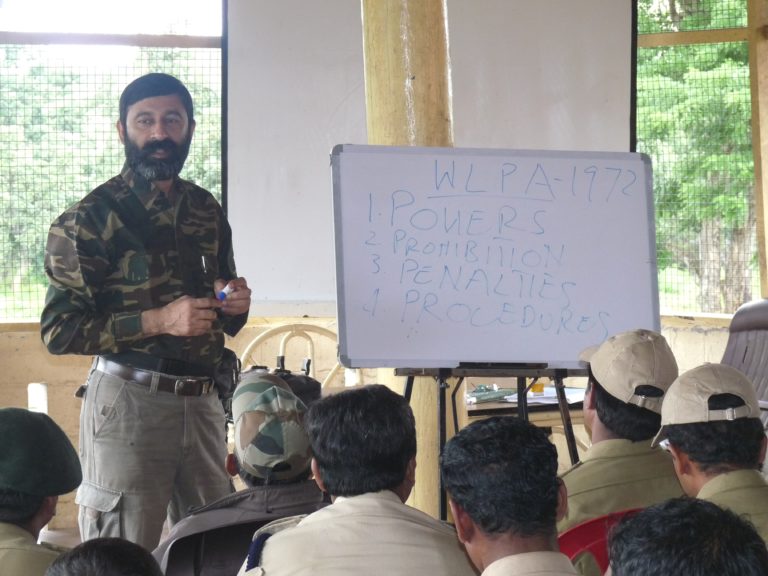This interview with Praveen Bhargav, Managing Trustee, Wildlife First, was conducted by Greenminute.in and is being reproduced here with permission.
With very few voices fighting for the noble cause of conservation of wildlife, the people in power need to lend their ears to their say and also make efforts to implement expert ideas. The current environmental situation has become so critical that people are caught between the devil and the deep sea with no assistance from either the federal government or the state governments. If they are not listening, we must make them listen for the sake of our future generations and the survival of Planet Earth. This is www.greenminute.in – first step to make policy makers listen to the wise words of our conservationists. We talk with conservationists, ecologists, researchers, wildlife biologists, green activists and of course, celebrities. Please help us, to help all.
Q1. Do you see any hope for conservation in the prevailing situation in view of the alarming rate of approvals for clearance of forest and wildlife habitats across the country?
Praveen Bhargav: We are indeed traversing a turbulent phase in conservation. There is overwhelming data to show that the systematic weakening of statutory bodies like the National Board for Wildlife (NBWL), Forest Advisory Committee (FAC) and Environment Appraisal Committees (EAC) is resulting in clearance rates that are alarmingly high. Facilitating ease of doing businesses has become the main business of the Ministry of Environment, Forest and Climate Change (MoEF & CC) which desecrates statutory and Constitutional obligations that it is duty bound to comply with. Along with this, the almost total capitulation of large conservation organizations, which are shying away from even commenting on major policy changes that are detrimental to forests and wildlife, is worrisome. Yet, there is reason to believe that it’s not all gloom and doom. This hope emerges from the fact that nearly 50 % of the Protected Areas (PAs) now have a notified Eco Sensitive Zone (ESZ). Additionally, a moratorium on new roads within PAs has been imposed, and many young conservationists / groups are actively campaigning to protect nature.
Q2. How do we make the people in power listen to wildlife experts during the current time?
PB: We need to be persistent, persuasive and proactive in our approach to reach out to decision makers. On-line campaigners must act responsibly by not flooding people in power, including the Prime Minister, every day, with verbose communication and opposing every project that is proposed. We also need to identify key think tanks / individuals, and sensitize them with scientifically valid information and, more importantly, present credible solutions and alternatives to carefully balance conservation imperatives with development aspirations. We also need to work with leaders when they are not in power and sensitize them on conservation aspects with briefings and even field visits. They will have sufficient time and may be more receptive to conservation ideas which may get implemented when they are back in power.
Q3. What are the immediate and future threats if we don’t act now to save what is left?
PB: The most important and immediate threats are from the intrusion of development projects into ecologically fragile areas without proper scrutiny. Along with encroachments, these are fragmenting the last remaining large blocks of natural forests due to a poorly crafted forest and wildlife clearance mechanism. Many such projects are redundant parallel alignments of roads, railway lines, non-site-specific projects or components of projects; grant of forest rights in intact blocks of forests and PAs is another major threat. All these are setting the stage for yet another round of massive encroachment and fragmentation in the coming decades. For the future, we need to ensure that forest connectivity across an altitudinal range is maintained to mitigate the impact of climate change on vegetation and plant communities. We need to question and correct three all-pervasive policy myths, viz. planting trees can compensate for the loss of natural forests; people and large wildlife can harmoniously co-exist; and water flowing into the ocean is a waste and should be diverted. Inter-linking of Rivers and National Waterways are two major threats in the coming future that will cause serious ecological and economic impact which scientists must point out to decision makers.
Q4. Is there any room for a five per cent protected area getting increased by a few more percentages? If yes, how?
PB: Absolutely. We can increase our PA network beyond 5% by amalgamating all notified forests that are contiguous with existing Protected Areas. This will ensure expansion of PAs and allow for protection and proper management. Additionally, we also need to analyse opportunities for consolidation of habitat through strategic acquisition of old plantation leases and large estates that are enclosures within PAs. A scientifically planned exercise of boundary rationalization of PAs, involving deletion of some low value areas and addition of at-least 10 x of intact habitat, should be considered as well to increase the overall size of PAs.
Q5. What are your concluding words for Conservationists?
PB: In these turbulent times, there is a great responsibility on every conservation activist to act sensibly, after due analysis of scientific data, before planning a campaign or intervention. The trend of rushing to court prematurely, with poorly crafted petitions and sweeping prayers must be eschewed. Spreading a sense of despondency amongst young activists by circulating doomsday predictions, stories and repeating problems ad nauseam does not help the cause. The best hope for securing positive decisions from the government or the courts is through building constructive partnerships with good public-spirited ecologists, sincere officials, and identifying viable alternatives to ecologically problematic projects.


 CI is a non-profit, non-commercial portal that aims to facilitate wildlife and nature conservation by providing reliable information and the tools needed to campaign effectively.
CI is a non-profit, non-commercial portal that aims to facilitate wildlife and nature conservation by providing reliable information and the tools needed to campaign effectively.